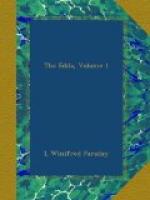When Thor goes fishing with the giant Hymi, he terrifies his companion by dragging the snake’s head out of the sea, but he does not slay it; it must wait there till Ragnaroek:
“The protector of men, the only slayer of the Serpent, baited his hook with the ox’s head. The God-hated one who girds all lands from below swallowed the bait. Doughtily pulled mighty Thor the poison-streaked serpent up to the side; he struck down with his hammer the hideous head of the wolf’s companion. The monster roared, the wilderness resounded, the old earth shuddered all through. The fish sank back into the sea. Gloomy was the giant when they rowed back, so that he spoke not a word.”
There is nothing to suggest that Joermungandr, to whom the word World-Snake (Midgardsorm) always refers in the Edda, is the same as Nidhoegg, the serpent that gnaws at Yggdrasil’s roots; but both are relics of Snake-worship.
* * * * *
The World-Ash, generally called Yggdrasil’s Ash, is one of the most interesting survivals of tree-worship. It is described by the Sibyl in Voeluspa: “I know an ash called Yggdrasil, a high tree sprinkled with white moisture (thence come the dews that fall in the dales): it stands ever-green by Urd’s spring. Thence come three maids, all-knowing, from the hall that stands under the tree”; and as a sign of the approaching doom she says: “Yggdrasil’s ash trembles as it stands; the old tree groans.” Grimnismal says that the Gods go every day to hold judgment by the ash, and describes it further:
“Three roots lie three ways under Yggdrasil’s ash: Hel dwells under one, the frost-giants under the second, mortal men under the third. The squirrel is called Ratatosk who shall run over Yggdrasil’s ash; he shall carry down the eagle’s words, and tell them to Nidhoegg below. There are four harts, with necks thrown back, who gnaw off the shoots.... More serpents lie under Yggdrasil’s ash than any one knows. Ofni and Svafni I know will ever gnaw at the tree’s twigs. Yggdrasil’s ash suffers more hardships than men know: the hart bites above, the side decays, and Nidhoegg gnaws below.... Yggdrasil’s ash is the best of trees.”
The snake and the tree are familiar in other mythologies, though in most other cases the snake is the protector, while here he is the destroyer. Both Nidhoegg and Joermungandr are examples of the destroying dragon rather than the treasure-guardian. The Ash is the oracle: the judgment-place of the Gods, the dwelling of the Fates, the source of the spring of knowledge.
* * * * *




